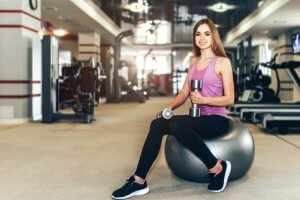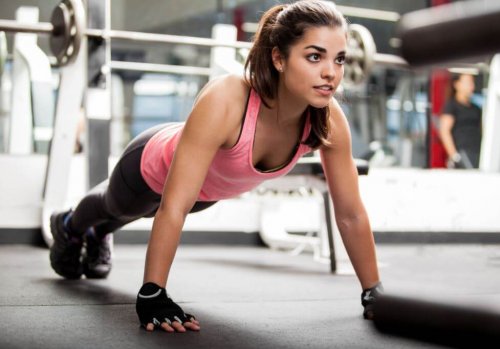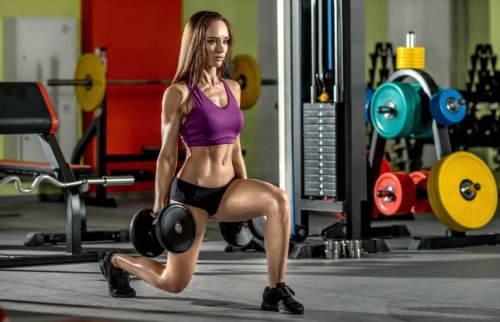Beginner Fitness Plan for Women

Beginner fitness tips for women
If you want to start working out, you might need some guidelines. With our pointers, you’ll be able to get the most out of your routines, be comfortable working out and prevent injuries:
1. Stretch sufficiently
You need to stretch your muscles before and after working out. Stretching before exercising will help you warm up the areas that you want to work out and stretching afterward will prevent them from getting too tense and hurting later.

2. Train for a maximum of 60 minutes
There’s a false belief that leads people to think that two hours at the gym are better than a 60-minute (more or less) workout routine. However, that’s simply not the case. Our muscles become tired and after a certain point, they stop working. Keeping your workout to one hour will prevent muscle fatigue that commonly results from overdoing it.
Working out every day is also something that you should avoid; give your body the time that it needs to recuperate. Schedule rest days between your workouts. To give you an idea, you could train Monday, Wednesday and Fridays while resting on Tuesday, Thursday, and Saturday.
3. Wear appropriate clothing
You can work out anywhere, whether it’s at the gym, home or the park. Wherever you go, do make sure, however, to wear the right clothing. Your clothes should be comfortable, although they don’t have to be a specific brand. The same is true for footwear.
4. Keep hydrated
Having the magic “two liters of water a day” is essential. When you exercise, you might want to drink even more water, especially for staying hydrated during your work out. Keeping hydrated will prevent dehydration and will help you get the most from your exercise.
Basic fitness routine for women
Now, you have the right clothing, a good work out schedule and the motivation to get started. So, all that’s left is to learn some basic exercises for your fitness plan:
1. Squats
Squats are the ultimate exercise and though many people hate doing them, they really develop our thighs and firm our glutes. There are dozens of squat variations out there, but to start off, try the original version:
Stand with your legs spread to the width of your hips. Keep your back straight at all times. Bending your knees, lower your trunk slowly. Your knees shouldn’t go over your toes. Hold the squat position for a couple of seconds and return to the starting position.

2. Push-ups
If it’s your first day at the gym, normal push-ups might be too difficult for you. The good news is that there are simpler versions that you can try to match your level (and you try harder versions as you become stronger).
Get on all fours, facing down, on a mat and place your hands forward, a little further from your head. Your elbows should be pointing behind you. Bend your legs and support your body weight on your knees. Bend your elbows and at the same time, move your torso forward, being careful not to surpass your fingertips.
Another push-up variation that you can try is a wall push-up. Stand facing a wall and support yourself on it with your hands, fully extending your arms. After, bend your elbows while moving your torso on a slant. Your feet should remain firmly in place!
3. Lunges
Another top exercise for beginner fitness is lunges. For lunges, you need to take a big step and lower your body as much as you can. Start by standing with your legs together.

Step forward with your right leg and bend both knees to lower your body. Keep your back straight the entire time and after a few seconds, return to the starting position and switch legs.
4. Bridge
This is a great exercise to work your pelvic and lower abdominal areas. Laying down on your back on a mat, bend your knees and prop up your legs, keeping the soles of your feet on the floor. Keep your arms next to your body. Slowly lift your torso off of the ground.
There are so many beginner exercises that you can include in your routine. Start with the basics and increase the intensity over time.
Beginner fitness tips for women
If you want to start working out, you might need some guidelines. With our pointers, you’ll be able to get the most out of your routines, be comfortable working out and prevent injuries:
1. Stretch sufficiently
You need to stretch your muscles before and after working out. Stretching before exercising will help you warm up the areas that you want to work out and stretching afterward will prevent them from getting too tense and hurting later.

2. Train for a maximum of 60 minutes
There’s a false belief that leads people to think that two hours at the gym are better than a 60-minute (more or less) workout routine. However, that’s simply not the case. Our muscles become tired and after a certain point, they stop working. Keeping your workout to one hour will prevent muscle fatigue that commonly results from overdoing it.
Working out every day is also something that you should avoid; give your body the time that it needs to recuperate. Schedule rest days between your workouts. To give you an idea, you could train Monday, Wednesday and Fridays while resting on Tuesday, Thursday, and Saturday.
3. Wear appropriate clothing
You can work out anywhere, whether it’s at the gym, home or the park. Wherever you go, do make sure, however, to wear the right clothing. Your clothes should be comfortable, although they don’t have to be a specific brand. The same is true for footwear.
4. Keep hydrated
Having the magic “two liters of water a day” is essential. When you exercise, you might want to drink even more water, especially for staying hydrated during your work out. Keeping hydrated will prevent dehydration and will help you get the most from your exercise.
Basic fitness routine for women
Now, you have the right clothing, a good work out schedule and the motivation to get started. So, all that’s left is to learn some basic exercises for your fitness plan:
1. Squats
Squats are the ultimate exercise and though many people hate doing them, they really develop our thighs and firm our glutes. There are dozens of squat variations out there, but to start off, try the original version:
Stand with your legs spread to the width of your hips. Keep your back straight at all times. Bending your knees, lower your trunk slowly. Your knees shouldn’t go over your toes. Hold the squat position for a couple of seconds and return to the starting position.

2. Push-ups
If it’s your first day at the gym, normal push-ups might be too difficult for you. The good news is that there are simpler versions that you can try to match your level (and you try harder versions as you become stronger).
Get on all fours, facing down, on a mat and place your hands forward, a little further from your head. Your elbows should be pointing behind you. Bend your legs and support your body weight on your knees. Bend your elbows and at the same time, move your torso forward, being careful not to surpass your fingertips.
Another push-up variation that you can try is a wall push-up. Stand facing a wall and support yourself on it with your hands, fully extending your arms. After, bend your elbows while moving your torso on a slant. Your feet should remain firmly in place!
3. Lunges
Another top exercise for beginner fitness is lunges. For lunges, you need to take a big step and lower your body as much as you can. Start by standing with your legs together.

Step forward with your right leg and bend both knees to lower your body. Keep your back straight the entire time and after a few seconds, return to the starting position and switch legs.
4. Bridge
This is a great exercise to work your pelvic and lower abdominal areas. Laying down on your back on a mat, bend your knees and prop up your legs, keeping the soles of your feet on the floor. Keep your arms next to your body. Slowly lift your torso off of the ground.
There are so many beginner exercises that you can include in your routine. Start with the basics and increase the intensity over time.
This text is provided for informational purposes only and does not replace consultation with a professional. If in doubt, consult your specialist.








